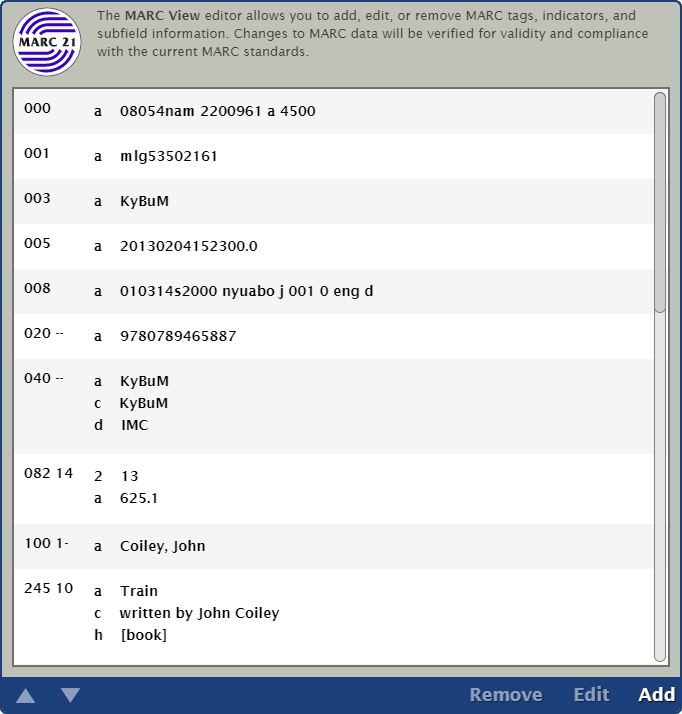Items
Related Blog Posts
Blog Posts
-
Items: a few things you may not know...
created by
Apr 12, 2023
-
Searching by Subject
created by
Nov 16, 2022
-
Assigning policies–the complete guide
created by
Mar 23, 2022
-
Title Assistant to the rescue!
created by
Jan 27, 2022
-
Overdue Items Notices? We've got you cover-ed
created by
Nov 24, 2021
-
Search smarter!—Combine search results
created by
Oct 13, 2021
-
Using Contents Notes
created by
Sep 23, 2021
-
Introducing... FAQs!
created by
Jul 07, 2021
-
Changing call numbers—helpful utilities
created by
Mar 03, 2021
-
From our librarians—Reusable book menu cards
created by
Nov 18, 2020
MAchine-Readable Cataloging (MARC) format is the way computers exchange and interpret bibliographic information. It makes it easy to store and transfer book or other library resource information between systems.
Resource Description & Access (RDA) is a "package of data elements, guidelines, and instructions for creating library and cultural heritage resource metadata that are well-formed according to international models for user-focused linked data applications." MARC format is commonly used to encode RDA data.
Basically, with the advancement of technology and more information being accessible on the internet, catalogers needed to rethink practices when it came to describing resources. So, RDA was introduced as a replacement to AACR2 in 2010. It's based on international standards, designed with the user in mind, compatible with existing records, and flexible.
See these resources for more information:
Important Changes
Not every library needs to change their MARC records to meet all RDA standards. But here are a few changes you should be aware of if you use Alexandria.
Series
Series information has moved from the 490 tag to the 830 tag. Alexandria uses the 830 tag for series searches in Researcher, so it's important for your series information to be in that tag.
To make sure all of your series information is in the right place, run the Fix Series utility. You can also run this utility anytime you import new MARC records and notice series information is in the 490 tag.
Publisher
Publisher information has moved from the 260 tag to the 264 tag.
Medium
Medium information has moved from the 245_h tag to the 366, 367, and 368 tags. That's right, medium is contained in three separate fields.
How does this work? Previously, medium was described with a General Material Designation (GMD), which is bracketed information that conveys the medium type = [electronic resource] Why? Some things have two types of mediums. some libraries use GMD to later patrons to the format of material (challenge with loss of GMD)
| Tag | Type | Examples |
|---|---|---|
| 336 | Content | text, performed music, spoken word, etc. |
| 337 | Media - What kind of device do you need to use this resource? | audio, video, etc. |
| 338 | Carrier - What kind of package is it in? | document, file, volume, audio disc, online resource, etc. |
For example, a physical book's medium is technically "text-unmediated-volume."
I can see why series is important for them to know, but why publisher and medium? just good practices?


